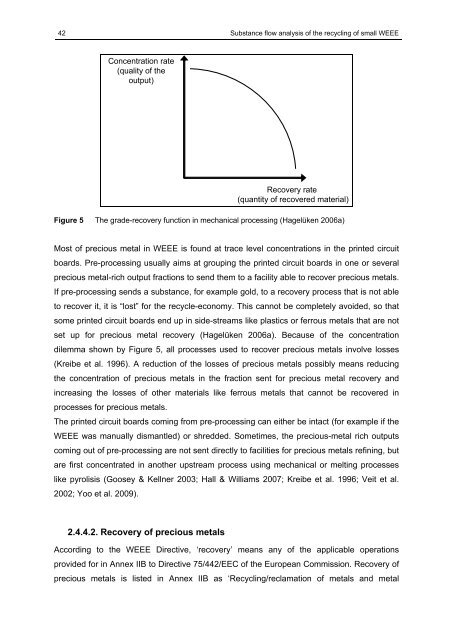SUbstance flow analysis of the recycling of small waste electrical ...
SUbstance flow analysis of the recycling of small waste electrical ...
SUbstance flow analysis of the recycling of small waste electrical ...
You also want an ePaper? Increase the reach of your titles
YUMPU automatically turns print PDFs into web optimized ePapers that Google loves.
42 Substance <strong>flow</strong> <strong>analysis</strong> <strong>of</strong> <strong>the</strong> <strong>recycling</strong> <strong>of</strong> <strong>small</strong> WEEE<br />
Concentration rate<br />
(quality <strong>of</strong> <strong>the</strong><br />
output)<br />
Recovery rate<br />
(quantity <strong>of</strong> recovered material)<br />
Figure 5 The grade-recovery function in mechanical processing (Hagelüken 2006a)<br />
Most <strong>of</strong> precious metal in WEEE is found at trace level concentrations in <strong>the</strong> printed circuit<br />
boards. Pre-processing usually aims at grouping <strong>the</strong> printed circuit boards in one or several<br />
precious metal-rich output fractions to send <strong>the</strong>m to a facility able to recover precious metals.<br />
If pre-processing sends a substance, for example gold, to a recovery process that is not able<br />
to recover it, it is “lost” for <strong>the</strong> recycle-economy. This cannot be completely avoided, so that<br />
some printed circuit boards end up in side-streams like plastics or ferrous metals that are not<br />
set up for precious metal recovery (Hagelüken 2006a). Because <strong>of</strong> <strong>the</strong> concentration<br />
dilemma shown by Figure 5, all processes used to recover precious metals involve losses<br />
(Kreibe et al. 1996). A reduction <strong>of</strong> <strong>the</strong> losses <strong>of</strong> precious metals possibly means reducing<br />
<strong>the</strong> concentration <strong>of</strong> precious metals in <strong>the</strong> fraction sent for precious metal recovery and<br />
increasing <strong>the</strong> losses <strong>of</strong> o<strong>the</strong>r materials like ferrous metals that cannot be recovered in<br />
processes for precious metals.<br />
The printed circuit boards coming from pre-processing can ei<strong>the</strong>r be intact (for example if <strong>the</strong><br />
WEEE was manually dismantled) or shredded. Sometimes, <strong>the</strong> precious-metal rich outputs<br />
coming out <strong>of</strong> pre-processing are not sent directly to facilities for precious metals refining, but<br />
are first concentrated in ano<strong>the</strong>r upstream process using mechanical or melting processes<br />
like pyrolisis (Goosey & Kellner 2003; Hall & Williams 2007; Kreibe et al. 1996; Veit et al.<br />
2002; Yoo et al. 2009).<br />
2.4.4.2. Recovery <strong>of</strong> precious metals<br />
According to <strong>the</strong> WEEE Directive, ‘recovery’ means any <strong>of</strong> <strong>the</strong> applicable operations<br />
provided for in Annex IIB to Directive 75/442/EEC <strong>of</strong> <strong>the</strong> European Commission. Recovery <strong>of</strong><br />
precious metals is listed in Annex IIB as ‘Recycling/reclamation <strong>of</strong> metals and metal

















